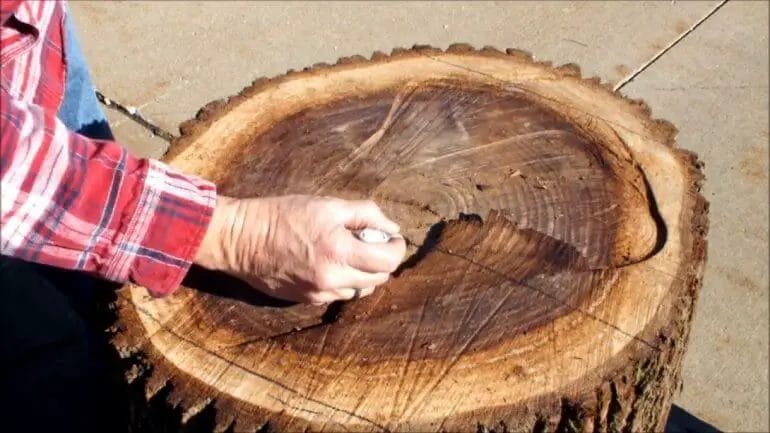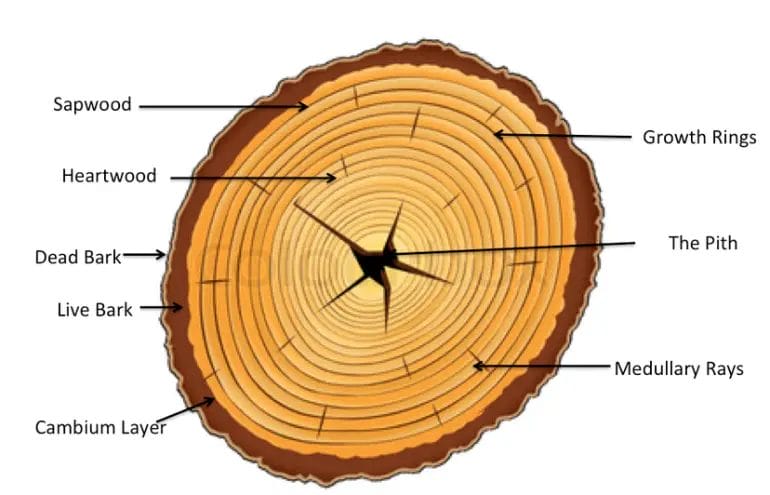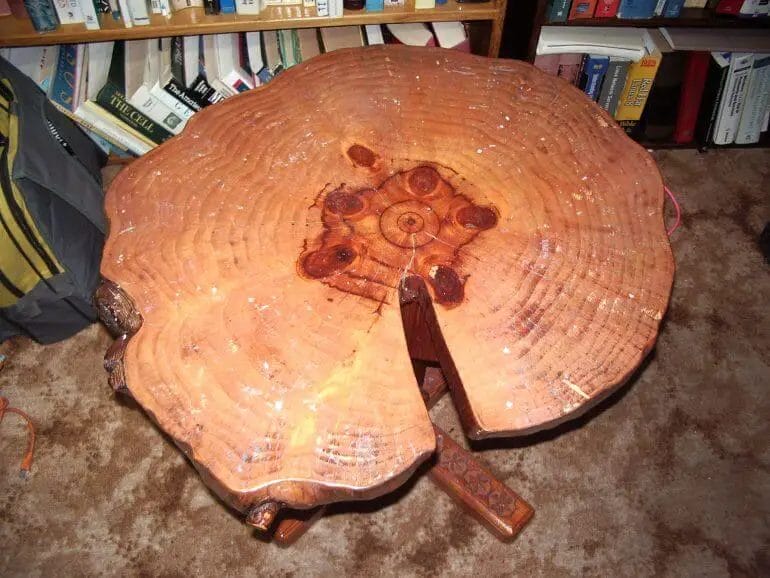Pith in wood refers to the central, soft, and spongy tissue found at the center of tree trunks and branches. It is the youngest part of the wood and is responsible for the transport of water and nutrients throughout the tree. The pith typically appears as a small, circular or oval-shaped area with a distinct texture.
Pith can vary in size and shape depending on the tree species and age. It is usually lighter in color compared to the surrounding wood and is less dense. While pith does not contribute significantly to the strength and durability of wood, it can impact woodworking processes, such as sawing, as it tends to be softer and can affect the structural integrity of the wood.

Woodworkers often need to carefully consider the presence of pith when working with wood, as it can affect the stability and overall quality of the finished product. Understanding the characteristics and behavior of pith is crucial for proper wood selection and ensuring the longevity of wood-based projects.

Anatomy and Structure of Pith in Wood: Understanding its composition and function
Wood is a natural material that holds great significance in various industries and applications. It is composed of several different components, each playing a vital role in its overall structure and function. One such component is the pith, which is an essential part of wood anatomy.
The pith, also known as the medulla, is the central core of a woody stem or branch. It is typically cylindrical in shape and extends vertically through the center of the wood. The pith is mainly composed of parenchyma cells, which are thin-walled and loosely packed. These cells are responsible for various functions within the wood.
Composition of Pith
The pith primarily consists of living parenchyma cells, which are responsible for storing and transporting nutrients throughout the plant. These cells have thin cell walls, making them efficient in conducting these essential functions. Additionally, the pith may also contain other types of cells, such as ray cells or resin ducts, depending on the wood species.
Furthermore, the pith contains intercellular spaces, which are filled with air or sap. These spaces provide flexibility to the wood and allow for expansion and contraction in response to environmental conditions. In some cases, the pith may also contain vascular bundles, which are responsible for transporting water and nutrients to other parts of the tree.
Function of Pith
The pith serves multiple functions within the wood structure. One of its primary roles is the storage and transport of nutrients. The parenchyma cells in the pith store carbohydrates, proteins, and other essential compounds required for the growth and development of the plant. These nutrients are transported to other parts of the plant, ensuring its overall health and vitality.
In addition to nutrient storage and transport, the pith also provides structural support to the wood. Its central position helps maintain the overall integrity and stability of the stem or branch. The pith acts as a core around which other wood components, such as the xylem and phloem, are arranged.
Moreover, the pith also plays a role in water storage and movement within the wood. The intercellular spaces in the pith allow for the absorption and retention of water, which is essential for the plant’s survival. This water can then be transported to other parts of the tree through the vascular bundles present in the pith.
In summary, the pith is a crucial component of wood anatomy, serving various functions related to nutrient storage, transport, and structural support. It is composed of parenchyma cells and may contain other cell types depending on the wood species. Understanding the anatomy and structure of pith in wood provides valuable insights into the composition and function of this essential plant material.

Pith Removal Techniques
Removing pith from wood is an essential step in woodworking projects. The pith, also known as the heartwood, is the soft, spongy center of a tree trunk. It is prone to shrinking, cracking, and warping, which can compromise the structural integrity of the wood. Therefore, it is important to remove the pith before using the wood for any project. In this section, we will discuss various methods and tools for effectively removing pith from wood.
1. Splitting
One of the simplest and most traditional methods of removing pith from wood is by splitting the log. This technique involves using a mallet and a wedge to split the log along its grain. By splitting the log, you can easily remove the pith, as it often separates from the surrounding wood fibers.
To split a log, start by making an initial cut along the length of the log using a chainsaw or a handsaw. Then, position a wedge into the cut and gently tap it with a mallet to split the log. Repeat this process until the log splits into two or more pieces. Once the log is split, you can easily remove the pith by hand or with the help of a chisel.
2. Planing
Another technique for removing pith from wood is by planing. Planing involves using a woodworking plane to shave off thin layers of wood from the surface, including the pith. This method is effective for removing the pith from smaller pieces of wood, such as boards and planks.
To remove the pith using a plane, start by securing the wood piece in a vice or on a workbench. Hold the woodworking plane at a slight angle to the wood surface and push it along the grain. Continue planing the wood until the pith is completely removed. Be sure to make smooth, even strokes to achieve the desired result.
3. Turning
If you are working with a cylindrical piece of wood, such as a log or a branch, turning on a lathe can be an effective method for pith removal. Turning involves mounting the wood piece on a lathe machine and using various turning tools to shape and remove material from the wood.
When turning a wood piece to remove the pith, start by securing it on the lathe using a chuck or a faceplate. Use a roughing gouge or a skew chisel to remove the bark and create a cylindrical shape. Then, use a parting tool or a spindle gouge to remove the pith by cutting it out from the center of the wood piece. Continue turning the wood until the pith is completely removed and the desired shape is achieved.
4. Chiseling
Chiseling is a versatile method for pith removal that can be used for both flat and curved surfaces. This technique involves using a chisel to carefully remove the pith from the wood, either by cutting or paring it away.
To remove the pith using a chisel, start by marking the area where the pith needs to be removed. Then, use a sharp chisel to carefully cut along the marked lines, gradually removing the pith. For curved surfaces, you can use a gouge or a carving chisel to shape and remove the pith. Be sure to work slowly and carefully to avoid damaging the surrounding wood.
5. Sawing
Sawing is another common method for pith removal, especially for larger wood pieces. This technique involves using a saw, such as a bandsaw or a table saw, to cut away the pith from the wood.
To remove the pith using a saw, start by securing the wood piece on a stable surface or a cutting jig. Use the saw to make straight cuts along the edges of the pith, gradually removing it from the wood. For curved cuts, you can use a coping saw or a scroll saw to carefully remove the pith. Remember to use proper safety precautions when operating power tools.
Removing pith from wood is a crucial step in woodworking projects to ensure the stability and durability of the final product. By utilizing techniques such as splitting, planing, turning, chiseling, and sawing, you can effectively remove the pith and prepare the wood for further processing. Each method has its advantages and is suitable for different types of wood and project requirements. Choose the technique that best fits your needs and always prioritize safety when working with tools.

The Effects of Pith on Wood Properties
Pith refers to the central portion of a tree trunk or branch, typically composed of soft, spongy tissue. In this section, we will examine how the presence of pith can impact the quality and characteristics of wood.
1. Structural Integrity:
The presence of pith in wood can have significant effects on its structural integrity. Pith is generally less dense than the surrounding wood, and its presence weakens the overall structure of the wood. This can lead to decreased load-bearing capacity and increased susceptibility to bending or breaking under stress.
2. Dimensional Stability:
Wood with pith tends to exhibit poor dimensional stability. Pith-containing wood is more prone to shrinking and swelling as a result of changes in moisture content. This can lead to warping, cracking, and distortion of the wood, making it less suitable for certain applications where dimensional stability is crucial.
3. Wood Density:
The presence of pith can significantly affect the density of wood. As mentioned earlier, pith is less dense than the surrounding wood, which means that wood with pith will generally have a lower overall density. This can impact its mechanical strength, hardness, and durability.
4. Knot Formation:
Pith is often associated with the formation of knots in wood. Knots are areas where branches or other parts of the tree intersect with the trunk, resulting in irregularities in the wood grain. These knots can weaken the wood and negatively impact its appearance and workability.
5. Moisture Content:
Wood with pith tends to have higher moisture content compared to wood without pith. This is because the pith contains more water-absorbing tissues. Higher moisture content can lead to increased susceptibility to decay, fungal growth, and insect infestation.
6. Workability:
The presence of pith can make wood more difficult to work with. Pith-containing wood is often softer and less stable, making it harder to shape, cut, and finish. It may also have a tendency to splinter or tear during machining processes.
7. Aesthetic Appeal:
Pith can have a negative impact on the aesthetic qualities of wood. The presence of pith can result in uneven coloration, visible knots, and irregular grain patterns, which may be undesirable for certain applications where the appearance of the wood is important.
In summary, the presence of pith in wood can have significant effects on its quality and characteristics. It can weaken the structural integrity, reduce dimensional stability, lower wood density, contribute to knot formation, increase moisture content, hinder workability, and diminish aesthetic appeal. Understanding these effects is crucial for selecting appropriate wood materials for various applications.
Pith in Different Wood Species
When it comes to studying the anatomy of wood, one cannot overlook the presence of pith. The pith is a central, cylindrical portion found in the cross-section of a tree trunk or branch. It plays a significant role in the growth and development of the tree, but its characteristics can vary across different wood species.
The pith, also referred to as the medulla, consists of soft, spongy tissue that is responsible for transporting water and nutrients throughout the tree. It serves as the tree’s central point of growth and helps in the formation of new wood cells. However, the size, shape, and composition of the pith can differ from one wood species to another.
Variations in Pith Size
The size of the pith can vary significantly between wood species. In some trees, such as pine or spruce, the pith is relatively small and appears as a tiny dot in the center of the cross-section. On the other hand, in larger trees such as oak or maple, the pith can be larger and more noticeable, resembling a distinct circular or oval shape.
It is important to note that the pith size is not necessarily related to the age or size of the tree. For instance, a young tree may have a relatively larger pith compared to an older tree of a different species. The variations in pith size are primarily determined by the genetic characteristics of the tree species.
Composition of Pith
The composition of the pith can also differ across various wood species. In general, the pith is composed of parenchyma cells, which are thin-walled and have large intercellular spaces. These cells are responsible for storing and transporting water and nutrients throughout the tree.
However, the density and arrangement of parenchyma cells can vary, resulting in differences in pith characteristics. Some wood species may have denser pith with closely packed cells, while others may have looser and more porous pith. These variations in pith composition can impact the overall density and strength of the wood.
Significance of Pith Variation
The variations in pith characteristics across different wood species can have practical implications for woodworking and timber utilization. Understanding the pith size and composition can help determine the quality and structural properties of the wood.
For example, wood with a larger pith may be more prone to cracking or warping due to the presence of a central void. Additionally, the density and porosity of the pith can affect the wood’s ability to absorb finishes or adhesives.
Furthermore, the presence of pith can impact the strength and stability of wood when it is cut and used for various applications. Woodworkers often consider the location of the pith when selecting boards for specific projects to ensure optimal structural integrity and minimize potential issues.
In summary, the pith in different wood species can exhibit significant variations in size and composition. While some species have small and inconspicuous pith, others may have larger and more prominent pith. The density and arrangement of parenchyma cells within the pith also differ, affecting the overall characteristics of the wood. Understanding the variations in pith can help woodworkers and timber users make informed decisions regarding the selection and utilization of different wood species.
FAQs
What is pith in wood?
Pith refers to the central portion of a tree trunk, located at the very center of the growth rings. It is softer and less dense compared to the surrounding wood, and usually has a different color and texture. Pith does not contribute much to the strength or structural integrity of the wood.
Conclusion
In conclusion, understanding the concept of pith in wood is crucial for anyone involved in woodworking or carpentry. The pith refers to the central, soft, and spongy portion of a tree trunk or branch. It plays a significant role in the growth and development of the tree, but it can also impact the quality and stability of the wood. Woodworkers must be aware of the pith’s location and its effects on the structural integrity and aesthetics of the finished product. By considering the pith’s characteristics and making informed decisions, craftsmen can create beautiful and durable wooden pieces.